Abstract
Activation of plasminogen by urokinase plasminogen activator (uPA) plays important roles in several physiologic and pathologic conditions. Cells secrete uPA as a single-chain molecule (scuPA). scuPA can be activated by proteolytic cleavage to a 2-chain enzyme (tcuPA). scuPA is also activated when it binds to its receptor (uPAR). The mechanism by which the enzymatic activity of the scuPA/suPAR complex is regulated is only partially understood. We now report that the plasminogen activator activity of the scuPA/suPAR complex is inhibited by Glu- and Lys-plasminogen, but not by mini-plasminogen. In contrast, neither Glunor Lys-plasminogen inhibits the activation of plasminogen by 2-chain uPA. Inhibition of scuPA/suPAR activity was evident at a Glu-plasminogen concentration of approximately 100 nM, and at physiologic plasma concentrations inhibition was nearly complete. A plasminogen fragment containing kringles 1-3 inhibited the enzymatic activity of scuPA/suPAR with an inhibition constant (Ki) equal to 1.9 μM, increased the Michaelis constant (Km) of scuPA/suPAR from 18 nM to 49 nM, and decreased the catalytic constant (Kcat) approximately 3-fold from 0.035 sec—1 to 0.011 sec—1. Inhibition of scuPA/suPAR by plasminogen was completely abolished in the presence of fibrin clots. These studies provide insight into the regulation of uPA-mediated plasminogen activation and identify a novel mechanism for its fibrin specificity.
Introduction
Urokinase type plasminogen activator (uPA) has been implicated in diverse physiologic and pathologic processes, including cancer invasiveness and metastasis,1-4 angiogenesis,5-8 inflammation,9 and fibrinolysis.10-12 uPA is synthesized as a single-chain molecule (scuPA) that expresses little or essentially no intrinsic13-15 plasminogen activator activity. scuPA can be activated by proteolytic cleavage at Leu158-Ile159 to a 2-chain enzyme (tcuPA),16 or it can be converted to an enzymatically active single-chain molecule by binding to its high-affinity cellular receptor (uPAR).17-19
Mice lacking uPA20 or uPAR21,22 appear to develop normally. Yet, mice lacking uPA are susceptible to lethal pulmonary infection by cryptococcus neoformans, an observation that has been attributed to impaired recruitment of inflammatory cells into the lung,9,23,24 and peritoneal macrophages from homozygous uPAR–/– mice display impaired cell-associated plasminogen activator activity.21 Fibrin clots typically contain neutrophils and macrophages that express uPAR and accelerate uPA-mediated clot lysis. In accordance with this, lysis of fibrin clots by macrophages from patients with paroxysmal nocturnal hemoglobinuria, who are predisposed to thrombosis and whose leukocytes lack cell surface uPAR, is impaired compared with cells from healthy individuals.25 These studies suggest that the binding of scuPA to uPAR is involved in clot lysis at plasma concentrations of reactants and that regulation of uPA/uPAR may play an important role in the pathogenesis of certain disease states.
Our previous studies showed that the scuPA/suPAR complex is a potent plasminogen activator with a capacity to lyse plasma clots that exceeds scuPA in vitro and in vivo.19 However, unlike tcuPA, which is rapidly and essentially irreversible inactivated by plasminogen activator type I (PAI-1), the inactivation of scuPA bound to soluble uPAR (suPAR) by PAI-1 is slow and reversible.26 Activation and inactivation of scuPA/suPAR also depends on the amino acid composition of the synthetic substrate used to detect the activity of the plasmin that is generated. Specifically, the activity of scuPA/suPAR is regulated by the plasmin substrate H-D-norleucyl-hexahydrotyrosyl-lysine-p-nitroanilide diacetate (*L*YK-P) but not by H-D-valyl-L-leucyl-L-lysine-p-nitroanilide diacetate (D-VLK-p).27,28
To date, the mechanism by which the activity of cell-associated uPA is constrained has not been fully elucidated. In the present paper we report that the plasminogen activator activity of the scuPA/suPAR complex is inhibited by physiologic concentrations of Glu-plasminogen. This inhibition by Glu-plasminogen is abolished by fibrin. These studies provide insight into the regulation of cell-associated uPA-mediated plasminogen activation and identify a novel mechanism underlying its fibrin specificity.
Materials and methods
Materials
Single-chain urokinase (scuPA) and recombinant soluble urokinase receptor (suPAR) were purified, characterized, and radiolabeled as previously reported.29,30 Glu-plasminogen, Lys-plasminogen and mini-plasminogen, and the plasmin substrate Spectrazyme-PL were kindly provided by American Diagnostica (Greenwich, CT). Lyophilized human fibrinogen depleted of plasminogen and thrombin, and human thrombin, were obtained from Sigma (St Louis, MO). 125I-Na was from Perkin-Elmer (Boston, MA). Recombinant tPA was from Genentech (South San Francisco, CA).
Generation of plasminogen fragment K1-3
cDNA encoding K1-3 of plasminogen (amino acids 78-338) was generated by polymerase chain reaction (PCR) using full-length plasminogen/pMT/BiP/V5 (kind gift of Dr F. Casetellino, University of Notre Dame) as the template and ggaagatctaaagtgtatctctcagagtgcaagactg and gtgggagccactcgagttactatactggggaggagtc as primers. The PCR product was digested with BglII and Xho and subcloned into pMT/BiP/V5. The recombinant proteins were expressed in Schneider S2 cells using the Drosophila Expression System (Invitrogen, Carlsbad, CA) according to the manufacturer's recommendations. K1-3 of plasminogen was purified from S2 media by affinity chromatography on lysine-Sepharose. K1-3 was eluted from the column with 0.1 M ϵ-aminocaproic acid (EACA) in 100 mM sodium phosphate buffer, pH 7.4, dialyzed against 0.1 M ammonium bicarbonate solution before being lyophilized. K1-3 migrated as a single band on sodium dodecyl sulfate–polyacrylamide gel electrophoresis (SDS-PAGE) and Western blot analysis with an antiplasminogen antibody (Ab 364R; kind gift of American Diagostica).
uPA noncleavable plasminogen (R561A)/cDNA encoding plasminogen-R561A/pMT/BiP/V5 (kind gift of Dr F. Casetellino, University of Notre Dame) was transfected into Schneider S2 cells and expressed using the Drosophila Expression System as described in the previous paragraph. Plasminogen R561A was purified from S2 media by affinity chromatography on lysine-Sepharose. The protein was eluted from the column with 0.1 M EACA in 0.1 M sodium phosphate buffer, pH 7.4, dialyzed against 0.1 M ammonium bicarbonate solution, and lyophilized. The molecular mass and homogeneity were determined using Western blot analysis performed with an antiplasminogen antibody (364R; American Diagostica). Plasminogen R561A was resistant to proteolysis by uPA as confirmed by SDS-PAGE.
Plasminogen activator activity
Plasminogen activator activity was determined by adding scuPA (5 nM) and an equimolar concentration of suPAR, or 5 nM tcuPA, to a reaction mixture containing various concentrations of Glu-, Lys-, or mini-plasminogen and the plasmin chromogenic substrate Spectrazyme PL (500 μM) in phosphate-buffered saline (PBS) at 37°C, and the light absorbance at 405 nm was measured continuously over time. The initial velocities of plasmin generation at different concentrations of plasminogen were calculated from the change in the A405 nm over time. The initial velocity of the reaction at each plasminogen concentration was obtained by calculating the change in the rate of A405 over different time intervals and the results were expressed as the change in optical density (ΔOD) per minute, which represents the slope of the initial velocity of plasminogen activation. To measure changes in the Michaelis constant (Km) and maximum velocity (Vmax) of plasmin generation, the rates of change in OD were compared with a standard curve made with known concentrations of plasmin, as described,18,31 and the results were calculated using a double reciprocal plot. In another set of experiments, a fixed concentration of Glu-plasminogen (20 nM) was added to suPAR (5 nM) and scuPA (5 nM) in the presence of various concentrations of plasminogen fragments, and the plasminogen activator activity was measured in the same way. In a third set of experiments, the capacity of various concentrations of kringles 1-3 to inhibit this reaction was calculated using a Dixon plot.
Plasminogen activation on cell surfaces
Monolayers of cultured human umbilical vein endothelial cells (HUVECs) were prepared as described.32 The cells were incubated in glycine buffer pH 3.0 for 5 minutes to remove endogenous uPA from cellular uPAR and then washed 3 times with PBS, pH 7.4. The cells were then incubated in PBS containing 15 nM Glu-plasminogen, 50 μM Spectrazyme PL, 5 nM scuPA or 5 nM tcuPA alone, or either uPA, in the presence of 1.5 μM K1-3 for 30 minutes. The buffer was removed, and the OD at 405 nm was measured.
Fibrinolytic activity
Purified human fibrinogen radiolabeled with 125I as described elsewhere19,33 was resuspended to a specific activity of 60 000 cpm/mL in PBS containing 3 mg/mL fibrinogen and increasing concentrations of Glu-plasminogen, or in plasminogen-free plasma repleted with plasminogen in the same way. In other experiments, plasminogen was added at a fixed concentration of 1 μM. Clots were formed by placing 0.4 mL soluble fibrinogen or plasma in 16-mm diameter tissue culture wells (Corning, Corning, NY) before adding thrombin (0.2 U/mL or 0.4 U/mL final concentration, respectively). Fibrinolysis was measured as described.19 Briefly, radiolabeled fibrin or plasma clots were overlaid with serum or PBS containing 25 nM scuPA/suPAR complex or 25 μL murine plasma (see “Fibrinogen concentration”) for 2 hours at 37°C, and radiolabeled soluble fibrin degradation products released into the overlying fluids were measured.
Binding of plasminogen R561A to scuPA/suPAR
Plasminogen R561A was radiolabeled with Na125I (Perkin-Elmer) using IODO-BEADS (Pierce, Rockford, IL) according to manufacturer's instructions. Free idodine was removed using Sephadex G-25 (PD-10; Amersham Pharmarcia Biotechnology, Piscataway, NJ). Microtiter plate wells (96-well) were coated overnight at 4°C with scuPA (10 μg/mL in 50 μL PBS per well) or the same amount of scuPA as preformed scuPA/suPAR complexes. The coating solution was removed and the unreactive sites were blocked with 1% bovine serum albumin (BSA) in PBS for one hour at room temperature. The blocking solution was aspirated, 125I-plasminogen R561A (200 nM) was added to each well in the presence or absence of 1.0 mM 6-aminohexanoic acid (6-AHA) for one hour at room temperature. The plates were washed 4 times in 1% BSA in PBS and the residual radioactivity was solubilized in 0.1 N NaOH and counted.
Fibrinogen concentration
Mice were injected with the specified amounts of scuPA or scuPA/suPAR. Two hours later, blood was drawn by cardiac puncture into sodium citrate (0.32% final concentration) and aprotinin (1 mg/mL final concentration). Plasma was prepared by centrifugation at 1500 g. Thrombin (1 U/mL) was added and the time to form a visible clot was measured. The concentration of fibrinogen in the plasma was determined by reference to the thrombin time measured in parallel using purified fibrinogen. In another set of experiments, 125I-fibrinogen resuspended in 0.5 mL saline supplemented with unlabeled fibrinogen (50 000 cpm/μL) was injected intravenously into mice immediately before injecting scuPA or scuPA/suPAR (11.3 mg/mL). Two hours later, blood was withdrawn and plasma was prepared as above. Thrombin (0.4 U/mL) was added and the radioactivity in the supernatant and precipitate were measured.
Binding of scuPA/suPAR to fibrin
scuPA and tPA were radiolabled to a specific activity of 380 000 cpm/mL32 and used at a final concentration of 100 nM. Binding of scuPA/suPAR to fibrin was determined as described.34 Briefly, plasminogen-free fibrinogen (3 mg/mL) in 0.05 M Tris-HCl buffer, pH 7.4, containing 0.038 M NaCl, 0.01% Tween 80, and 1 mg/mL BSA was clotted by addition of thrombin (0.4 U/mL final concentration) in the presence of 125I-scuPA/suPAR or 125I-tPA (5 nM each) for 20 minutes at 37°C. The clots were sedimented, washed 4 times with buffer, and the radioactivity in the supernatant and in the fibrin clots was measured as described.34
Proteolysis of radiolabeled globin and fibrinogen
Fibrinogen was iodinated using IODO-BEADS as described in “Binding of plasminogen R561A to scuPA/suPAR.” 14C-globin was prepared by carbamylation of hemoglobin with K14 potassium isothiocyanate (CNO) followed by separation of globin from heme as described.35 Proteolysis of labeled proteins was measured.35 Briefly, scuPA/suPAR or tcuPA were incubated with Glu-plasminogen (1 μM unless otherwise stated) and 14C-globin (0.75 mg/mL) for 3 hours at 37°C. The reaction was terminated by addition of 250 mL 50% (wt/wt) ice-cold trichloroacetic acid (TCA). After centrifugation, the TCA-soluble supernatant was counted in a gamma counter. Proteolysis of 125I-fibrinogen (3.8 mg/mL) was measured in the same way.
Immunoprecipitation
Mice were injected with 0.5 mL 125I-scuPA or 125I-scuPA/suPAR. Three minutes later, blood was withdrawn into citrate and plasma was prepared as described in “Binding of plasminogen R56A to scuPA/suPAR.” The plasma (0.5 mL) was incubated with PBS (0.5 mL) containing anti-uPAR IgG for 2 hours at 4°C and 0.3 mL protein G–Agarose was added for an additional 2 hours. The beads were centrifuged at 1500 g for 10 minutes and the supernatant was decanted. The precipitate was washed 3 times with RIPA buffer,36,37 and the radioactivity was measured.
Results
Fibrin specificity of the scuPA/suPAR complex
We have previously reported that the complex between scuPA and suPAR is a potent plasminogen activator and that its fibrinolytic activity exceeds that of scuPA alone, both in vitro19 and in vivo.12 Whether this activity is specific for fibrin, and if this is the case, the mechanism underlying this fibrin specificity has not been established.
To address these issues, we first compared the consumption of plasma fibrinogen in vivo in mice injected with scuPA, to that in animals given an equal amount of scuPA as preformed scuPA/suPAR complexes. ScuPA was injected at concentrations that lyse plasma clots. 12,19 Mice were injected intravenously with scuPA/suPAR in doses ranging from 0.1 mg/kg to 11.3 mg/kg (∼4.4 μM estimated maximal initial plasma concentration) and the concentration of fibrinogen in plasma was measured 2 hours later. Even at the highest concentrations injected, scuPA/suPAR had no effect on the plasma concentration of fibrinogen (Figure 1A). In contrast, the same amount of injected scuPA decreased the plasma concentration of fibrinogen by more than 50% (Figure 1B).
Effect of scuPA/suPAR on plasma fibrinogen concentrations. (A) Four groups of mice (4-5 mice per group) were injected with 11.3 mg/kg scuPA/suPAR complex. (B) Mice (4-5 mice per group) were injected with scuPA alone (11.3 mg/kg) or saline control (Cont.). Two hours later, blood was drawn, plasma was separated, and the fibrinogen concentration was measured. The mean ± SD from 3 animals in each group is shown.
Effect of scuPA/suPAR on plasma fibrinogen concentrations. (A) Four groups of mice (4-5 mice per group) were injected with 11.3 mg/kg scuPA/suPAR complex. (B) Mice (4-5 mice per group) were injected with scuPA alone (11.3 mg/kg) or saline control (Cont.). Two hours later, blood was drawn, plasma was separated, and the fibrinogen concentration was measured. The mean ± SD from 3 animals in each group is shown.
As a second approach, mice were injected with 125I-fibrinogen immediately before injecting (11.3 mg/kg) scuPA or scuPA/suPAR. scuPA caused more extensive proteolysis of 125I-fibrinogen than an equal amount of scuPA/suPAR (Figure 2A). Plasma from these animals was then tested ex vivo for fibrinolytic activity using radiolabeled plasma clots as the substrate.19 Although plasma from the scuPA-treated mice caused greater cleavage of fibrinogen in vivo (Figure 2A), plasma from the mice injected with scuPA/suPAR retained greater fibrinolytic activity ex vivo (Figure 2B). The basis for this divergence is considered below.
Catalytic activity and integrity of plasma scuPA/suPAR complexes. (A) Lysis of fibrinogen: 125I-fibrinogen was injected intravenously immediately before injecting saline alone (Cont.) or saline containing 11.3 mg/kg scuPA or the scuPA/suPAR complex. Two hours later, blood was collected, plasma prepared, and the release of radiolabeled fibrinogen degradation products (FDPs) into the plasma was measured. (B) Lysis of plasma clots: 11.3 mg/kg scuPA or scuPA/suPAR was injected; 2 minutes later, blood was collected, plasma prepared, and the capacity of the plasma from control animals (Cont.) or those injected with scuPA or scuPA/suPAR to lyse 125I-plasma clots was measured. (C) 125I-scuPA or 125I-scuPA/suPAR complex (11.3 mg/kg) was injected intravenously. Two minutes later blood was taken, plasma prepared, and plasma radioactivity was precipitated using anti-uPAR antibodies. In all panels, results from 4 mice (mean ± SD) are shown.
Catalytic activity and integrity of plasma scuPA/suPAR complexes. (A) Lysis of fibrinogen: 125I-fibrinogen was injected intravenously immediately before injecting saline alone (Cont.) or saline containing 11.3 mg/kg scuPA or the scuPA/suPAR complex. Two hours later, blood was collected, plasma prepared, and the release of radiolabeled fibrinogen degradation products (FDPs) into the plasma was measured. (B) Lysis of plasma clots: 11.3 mg/kg scuPA or scuPA/suPAR was injected; 2 minutes later, blood was collected, plasma prepared, and the capacity of the plasma from control animals (Cont.) or those injected with scuPA or scuPA/suPAR to lyse 125I-plasma clots was measured. (C) 125I-scuPA or 125I-scuPA/suPAR complex (11.3 mg/kg) was injected intravenously. Two minutes later blood was taken, plasma prepared, and plasma radioactivity was precipitated using anti-uPAR antibodies. In all panels, results from 4 mice (mean ± SD) are shown.
Experiments were then performed to determine whether the fibrinolytic activity of scuPA/suPAR is due to the proteolytic conversion of scuPA to tcuPA either while still bound to the receptor or after its elution. To examine this question, mice were injected with either tcuPA or tcuPA/suPAR at the same concentrations shown in Figure 1. As expected, both tcuPA and tcuPA/suPAR caused a greater reduction in plasma fibrinogen than scuPA or scuPA/suPAR, decreasing the circulating concentrations of fibrinogen from 263 mg/dL ± 42 mg/dL to 53 mg/dL ± 21 mg/dL and 76 mg/dL ± 34 mg/dL, respectively. In contrast, scuPA/suPAR had no effect on the plasma fibrinogen concentration (Figure 1).
Taken together, these data strongly suggest that the fibrinolytic activity is initiated by a complex between scuPA and suPAR. To test this assumption directly, mice were injected with complexes prepared with 125I-scuPA/suPAR. Three minutes later, consistent with its half-life (t1/2) in plasma,12 blood samples were taken, plasma was prepared, and the complexes were immunoprecipitated with anti-uPAR antibodies.37 Anti-uPAR precipitated 125I-scuPA only when it was injected together with suPAR, consistent with preservation of the complex (Figure 2C). The same results were obtained when the experiment was performed in the presence of 2 μM Glu-plasminogen in saline (data not shown), indicating that plasminogen does not disrupt complex formation in this setting.
To examine the mechanism underlying the fibrin specificity of the scuPA/suPAR complex in greater detail, we compared its plasminogen activator activity using radiolabeled fibrin and globin as substrates. scuPA/suPAR (25 nM) did not lyse clots prepared from purified fibrinogen. However, lysis was readily observed when serum was present (Figure 3A), consistent with our previous observations.19 In contrast, scuPA/suPAR (25 nM) caused minimal proteolysis of radiolabeled globin either by itself or in the presence of serum (Figure 3A), indicating that serum does not induce scuPA/suPAR plasminogen activator activity. In contrast to scuPA/suPAR, tcuPA caused significant cleavage of both substrates in the absence of serum, and addition of serum inhibited tcuPA-mediated clot lysis (Figure 3B). This indicates that the inability of scuPA/suPAR to induce the proteolysis of globin is not due to the inability of plasmin to proteolyse this substrate. These latter results both affirm the fibrin specificity of the complex and indicate that fibrin alone is not sufficient for scuPA/suPAR to express plasminogen activator activity. In support of this, we did not detect binding of scuPA/suPAR to fibrin clots, in contrast to the binding observed with tPA (Figure 4).
The plasminogen activator activity of scuPA/suPAR is fibrin dependent. (A) scuPA/suPAR (50 nM) was incubated with 125I-fibrin clots or 125I-globin in presence of 1 μM Glu-plasminogen and in the presence or absence of human serum. (B) The same experiment was performed except that tcuPA (25 nM) was added instead of the scuPA/suPAR complex. The 100% point represents fibrinolysis induced by scuPA (A) or tcuPA alone (B). In this and in all experiments that follow, the mean ± SD of 3 separate experiments is shown unless stated otherwise.
The plasminogen activator activity of scuPA/suPAR is fibrin dependent. (A) scuPA/suPAR (50 nM) was incubated with 125I-fibrin clots or 125I-globin in presence of 1 μM Glu-plasminogen and in the presence or absence of human serum. (B) The same experiment was performed except that tcuPA (25 nM) was added instead of the scuPA/suPAR complex. The 100% point represents fibrinolysis induced by scuPA (A) or tcuPA alone (B). In this and in all experiments that follow, the mean ± SD of 3 separate experiments is shown unless stated otherwise.
Binding of scuPA and t-PA to fibrin.125I-scuPA/suPAR (4 nM) or 125I-tPA (1.5 nM) was added to soluble fibrinogen (3 mg/mL), and thrombin (0.4 U/mL) was added for 40 minutes at 37°C. The clot was sedimented and the radioactivity in the supernatant fraction was measured and subtracted from the total. The graph shows the percentage of the total radioactivity that remained in the pellet.
Binding of scuPA and t-PA to fibrin.125I-scuPA/suPAR (4 nM) or 125I-tPA (1.5 nM) was added to soluble fibrinogen (3 mg/mL), and thrombin (0.4 U/mL) was added for 40 minutes at 37°C. The clot was sedimented and the radioactivity in the supernatant fraction was measured and subtracted from the total. The graph shows the percentage of the total radioactivity that remained in the pellet.
Regulation of scuPA/suPAR plasminogen activator activity by plasminogen
To pursue the implications of the fibrin and serum dependence of scuPA/suPAR-mediated fibrinolysis, we took 2 findings into account. First, scuPA binds to plasminogen.38 Second, the data of Scully et al39 strongly suggests that scuPA interacts with the kringles of plasmin. Therefore, we next examined the effect of plasminogen on the plasminogen activator activity of the scuPA/suPAR complex.
The data presented in Figure 5 show the effect of increasing concentrations of Glu-plasminogen on plasminogen activator activity mediated by scuPA/suPAR. A dose-dependent increase in plasmin formation was measured at concentrations of plasminogen up to 80 nM, as expected. However, at concentrations above 160 nM, a dose-dependent inhibition of plasmin formation was observed. At near-physiologic plasma concentrations (1.44 μM), inhibition of PA activity was almost complete; that is, the activity was only 4% of that seen at optimal (80 nM) concentrations of plasminogen.
Effect of plasminogen on the plasminogen activator activity of scuPA/suPAR. Increasing concentrations of Glu-plasminogen (♦), Lys-plasminogen (□), and mini-plasminogen (▪) were incubated with scuPA (5 nM), suPAR (5 nM), and the plasmin chromogenic substrate (0.5 mM), and the OD at 405 nm was measured continuously over the next 20 minutes. The data are expressed as change in OD per minute.
Effect of plasminogen on the plasminogen activator activity of scuPA/suPAR. Increasing concentrations of Glu-plasminogen (♦), Lys-plasminogen (□), and mini-plasminogen (▪) were incubated with scuPA (5 nM), suPAR (5 nM), and the plasmin chromogenic substrate (0.5 mM), and the OD at 405 nm was measured continuously over the next 20 minutes. The data are expressed as change in OD per minute.
Glu-plasminogen, the predominant form of plasminogen in plasma, assumes a predominantly closed structure40 Cleavage of Glu-plasminogen by plasmin liberates its N-terminal 77 amino acids and thereby causes the molecule, designated Lys-plasminogen, to assume a more open conformation that renders it more susceptible to activation by uPA.41 Therefore, we next examined the effect of releasing this N-terminal fragment on the capacity of plasminogen to regulate its subsequent activation by scuPA/suPAR. Lys-plasminogen exerts a biphasic effect on scuPA/suPAR-mediated plasminogen activation, similar to that seen with Glu-plasminogen (Figure 5). Maximal activity was seen at a Lys-plasminogen concentration of 160 nM, whereas the activity of scuPA/suPAR was inhibited at higher concentrations. However, Lys-plasminogen was a less potent inhibitor of scuPA/suPAR (Figure 5). Even at the highest concentration tested (1.44 μM), inhibition of suPAR/scuPA by Lys-plasminogen was only approximately 65% of that seen at optimal substrate concentrations (160 nM). This stands in contrast to the near total inhibition seen at the same concentrations of Glu-plasminogen.
Lys-plasminogen is composed of 5 kringle structures and the protease domain.42 Several experiments were performed to delineate their involvement in the regulation of scuPA/suPAR. First, we examined the activity of scuPA/suPAR in the presence of mini-plasminogen, which lacks the kringles 1-4. Mini-plasminogen, like Glu- and Lys-plasminogen, induced a dose-dependent increase in scuPA/suPAR-mediated plasmin formation (Figure 5). In contrast, mini-plasminogen did not inhibit scuPA/suPAR activity, even at concentrations as high as 1400 nM.
The observation that above certain concentrations both Glu- and Lys-plasminogen inhibit scuPA/suPAR, indicates that amino acids 1-77 are not essential for this effect. The fact that mini-plasminogen did not inhibit suPAR/scuPA under the same conditions suggests that the negative regulatory element is situated within a plasminogen fragment that begins at amino acid 78 and includes kringles 1-4. Therefore, we next examined the effect of kringles 1-3, a plasminogen fragment that has been described to have antiangiogenic activity,43,44 on plasminogen activation by the scuPA/suPAR complex. Plasminogen kringles 1-3 (2 μM) inhibited scuPA/suPAR-mediated plasminogen activator activity by more than 50%, similar to the inhibitory effect of Lys-plasminogen at this concentration (Figure 6). Kringles 1-3 did not inhibit the activation of plasminogen by tcuPA or scuPA (Figure 6) or by the tcuPA/suPAR complex (not shown).
Effect of plasminogen kringles on scuPA/suPAR activity. A plasminogen fragment composed of kringles 1-3 (2 μM) was incubated with 5 nM scuPA/suPAR complex (Comp.), scuPA (5 nM), or tcuPA (5nM). Glu-plasminogen (20 nM) and the plasmin chromogenic substrate (0.5 mM) were added and the OD was measured continuously over the next 20 minutes.
Effect of plasminogen kringles on scuPA/suPAR activity. A plasminogen fragment composed of kringles 1-3 (2 μM) was incubated with 5 nM scuPA/suPAR complex (Comp.), scuPA (5 nM), or tcuPA (5nM). Glu-plasminogen (20 nM) and the plasmin chromogenic substrate (0.5 mM) were added and the OD was measured continuously over the next 20 minutes.
The kinetics of the inhibition of scuPA/suPAR activity by plasminogen kringles 1-3 were then examined in greater detail. To do so, scuPA/suPAR was incubated with various concentrations of kringles 1-3, and the residual activity of the complex was analyzed using a Dixon plot. Kringles 1-3 inhibit the enzymatic activity of scuPA/suPAR with an inhibition constant (Ki) of 1.9 μM (Figure 7A). The activity of scuPA/suPAR was then measured in the presence of kringles 1-3 (1.9 μM) and increasing concentrations of plasminogen (8 nM-30 nM), within the range that does not inhibit plasminogen activation. The Km of the scuPA/suPAR complex increased from 18 nM to 49 nM in the presence of plasminogen (Figure 7B) and the catalytic constant (Kcat) decreased from 0.035 sec–1 to 0.009 sec–1, indicating an uncompetitive pattern of inhibition. This pattern suggests that the inhibitor or inhibitors (kringle 1-3, Glu-, or Lys-plasminogen) interacts with the scuPA/suPAR complex at a site that is distinct from the catalytic site of the enzyme.
Kinetics of inhibition of scuPA/suPAR activity by plasminogen kringle 1-3. (A) Dixon plot. The plasminogen activator activity of the scuPA/suPAR complex was measured in the presence of various concentrations of plasminogen kringle 1-3. The apparent Ki of kringle 1-3 is 1.9 μM. (B) Effect of kringle 1-3 on Km and Vmax of Glu-plasminogen activation by scuPA/suPAR at different concentrations of plasminogen. scuPA (10 nM) was incubated with an equimolar concentration of suPAR and Glu-plasminogen (8 nM-30 nM) in the presence (▵) or absence (□) of 1.9 μM K1-3. Plasmin activity is plotted as 1/velocity of the reaction versus 1/substrate concentration. The results shown are from one experiment representative of 2 performed.
Kinetics of inhibition of scuPA/suPAR activity by plasminogen kringle 1-3. (A) Dixon plot. The plasminogen activator activity of the scuPA/suPAR complex was measured in the presence of various concentrations of plasminogen kringle 1-3. The apparent Ki of kringle 1-3 is 1.9 μM. (B) Effect of kringle 1-3 on Km and Vmax of Glu-plasminogen activation by scuPA/suPAR at different concentrations of plasminogen. scuPA (10 nM) was incubated with an equimolar concentration of suPAR and Glu-plasminogen (8 nM-30 nM) in the presence (▵) or absence (□) of 1.9 μM K1-3. Plasmin activity is plotted as 1/velocity of the reaction versus 1/substrate concentration. The results shown are from one experiment representative of 2 performed.
To study the interaction between scuPA/suPAR and plasminogen in greater detail, we measured the capacity of the complex to bind plasminogen. To do so, uPA insensitive 125I-plasminogen R561A was added to dishes precoated with equal amounts of scuPA or scuPA/suPAR. scuPA binds to plasminogen R561A, as described by Lijnen et al,38 as does scuPA/suPAR (Figure 8). In both cases, binding of plasminogen is almost completely inhibited by 6-AHA, supporting the contention that the kringles of plasminogen are primarily responsible for the binding and inhibition of scuPA/suPAR activity.
Binding of 125I-plasminogen R561A to scuPA/suPAR.125I-plasminogen R561A (200 nM) was added to microtiter plates precoated with scuPA alone (filled columns) or with an equimolar concentration of scuPA/suPAR complex (open columns), in the presence or absence of 1 mM 6-AHA.
Binding of 125I-plasminogen R561A to scuPA/suPAR.125I-plasminogen R561A (200 nM) was added to microtiter plates precoated with scuPA alone (filled columns) or with an equimolar concentration of scuPA/suPAR complex (open columns), in the presence or absence of 1 mM 6-AHA.
Activation of fibrinolysis by scuPA/suPAR
The observation that plasminogen inhibits the activity of scuPA/suPAR at subphysiologic plasma concentrations fails to explain how the complex could activate plasminogen under pathophysiologic conditions. To address this question we first depleted plasma of plasminogen. Plasminogen-free plasma was then repleted with radiolabeled fibrinogen and varying amounts of exogenous plasminogen. Clots were then formed as described previously19 and their cleavage by scuPA/suPAR was measured. Plasminogen lost its capacity to inhibit the activity of scuPA/suPAR in the presence of plasma clots (Figure 9).
Effect of plasminogen on the plasminogen activator activity of suPAR/scuPA in presence of plasma-derived clots. Plasminogen-depleted plasma containing 125I-fibrinogen was supplemented with increasing concentrations of plasminogen. Clots were formed by adding thrombin. scuPA/suPAR (25 nM) was added for 2 hours at 37°C and the release of radioactivity into the supernatant was measured.
Effect of plasminogen on the plasminogen activator activity of suPAR/scuPA in presence of plasma-derived clots. Plasminogen-depleted plasma containing 125I-fibrinogen was supplemented with increasing concentrations of plasminogen. Clots were formed by adding thrombin. scuPA/suPAR (25 nM) was added for 2 hours at 37°C and the release of radioactivity into the supernatant was measured.
In view of this observation and the finding that fibrin is needed to detect the fibrinolytic activity of scuPA/suPAR (Figure 3A), we asked if fibrin was able to restore the plasminogen activation activity of the complex in the presence of plasminogen. In accordance with this concept, plasminogen did not inhibit scuPA/suPAR-mediated fibrinolysis in the presence of clots prepared from fibrinogen (Figure 10). Moreover, plasminogen inhibited scuPA/suPAR-mediated, plasmin-dependent lysis of 14C-globin (Figure 11A), as well as lysis of 125I-fibrinogen (Figure 11B).
Effect of fibrin on plasminogen-mediated inhibition of scuPA/suPAR activity. Increasing concentrations of Glu-plasminogen were added to a solution containing 125I-fibrinogen (3 mg/mL). Clots were formed by adding thrombin as in Figure 9. scuPA/suPAR (40 nM) was added for 2 hours at 37°C and the release of radioactivity into the supernatant was measured.
Effect of fibrin on plasminogen-mediated inhibition of scuPA/suPAR activity. Increasing concentrations of Glu-plasminogen were added to a solution containing 125I-fibrinogen (3 mg/mL). Clots were formed by adding thrombin as in Figure 9. scuPA/suPAR (40 nM) was added for 2 hours at 37°C and the release of radioactivity into the supernatant was measured.
Effect of plasminogen on proteolysis of globin and fibrinogen by scuPA/suPAR. scuPA/suPAR (25 nM) was incubated with C14-globin (A) or 125I-fibrinogen (B) in the presence of increasing concentrations of Glu-plasminogen at 37°C for 3 hours. Radioactivity in the TCA-soluble supernatants that contained cleavage products of 14C-globin or 125I-fibrinogen was measured.
Effect of plasminogen on proteolysis of globin and fibrinogen by scuPA/suPAR. scuPA/suPAR (25 nM) was incubated with C14-globin (A) or 125I-fibrinogen (B) in the presence of increasing concentrations of Glu-plasminogen at 37°C for 3 hours. Radioactivity in the TCA-soluble supernatants that contained cleavage products of 14C-globin or 125I-fibrinogen was measured.
Fibrin and 6-AHA both bind to lysine binding sites in plasminogen,41 and 6-AHA inhibits the binding of plasminogen to scuPA/suPAR (Figure 8). Consequently, we asked whether 6-AHA would recapitulate the capacity of fibrin to restore the inhibitory activity of plasminogen on scuPA/suPAR. Indeed, the inhibitory activity of plasminogen was not expressed in the presence of 1 μM 6-AHA (Figure 12).
Effect of 6-AHA on the inhibition of scuPA/suPAR by plasminogen. The plasminogen activator activity of scuPA/suPAR complex (5 nM; Comp.) was determined as in Figures 5 and 6 using a fixed concentration of plasminogen (1 μM) and in absence (Comp.) or presence of 0.1 mM 6-AHA (Comp. + 6AHA).
Regulation of cell-associated uPA plasminogen activator activity
Last, we asked if our findings hold true in the physiologic context of cell-associated plasminogen activation. Therefore, we examined the effect of K1-3 on the cell-associated plasminogen activator activity of scuPA using HUVECs as the source of uPAR. Cells were pretreated with glycine buffer, pH 3, to elute endogenous uPA. scuPA or tcuPA (5 nM) was added alone or in the presence of K1-3 (1.5 μM), followed by 15 nM plasminogen and the plasmin chromogenic substrate. K1-3 inhibited the activation of plasminogen to plasmin when scuPA was added, but did not affect the plasminogen activator activity of tcuPA (Figure 13).
Regulation of cell-associated scuPA by plasminogen. HUVECs were preincubated with glycine buffer, pH 3, washed, and PBS (Cont.) or PBS containing scuPA or tcuPA (5 nM) alone or in the presence of 1.5 μM K1-3. Glu-plasminogen (15 nM) and Spectrazyme PL (50 μM) were added for 20 minutes. The buffer was removed and the OD at 405 nm was measured.
Regulation of cell-associated scuPA by plasminogen. HUVECs were preincubated with glycine buffer, pH 3, washed, and PBS (Cont.) or PBS containing scuPA or tcuPA (5 nM) alone or in the presence of 1.5 μM K1-3. Glu-plasminogen (15 nM) and Spectrazyme PL (50 μM) were added for 20 minutes. The buffer was removed and the OD at 405 nm was measured.
Discussion
We have previously reported that the complex between scuPA and uPAR, or its soluble counterpart suPAR, expresses plasminogen activator activity, but the complex has kinetic properties18 and is regulated26,27 in a manner that differs from that of tcuPA and tPA. In the present paper, we report that the scuPA/suPAR complex, unlike scuPA or tcuPA, did not deplete plasma fibrinogen in mice at a concentration 45-fold higher than was shown previously to express fibrinolytic activity in vivo.12
The mechanism underlying the fibrin specificity of the scuPA/suPAR complex differs from that previously reported for other plasminogen activators. Our findings indicate that the catalytic activity of the scuPA/suPAR complex is inhibited by physiologic concentrations of its substrate plasminogen. The inhibitory activity resides in plasminogen fragments composed of kringles 1-3. The inhibitory effect of plasminogen was completely abolished by fibrin but not by other plasma components, including fibrinogen. Kringles 1-3 also inhibited endothelial cell–associated scuPA-mediated plasminogen activation.
Based on our findings, we postulate that the activity of scuPA/suPAR is restrained in plasma by plasminogen in the absence of fibrin clots. Fibrin reverses this inhibition, allowing fibrinolysis to proceed. Once substantial clot lysis has occurred, plasminogen-mediated inhibition is restored.
The mechanism that we propose to explain the fibrin specificity of the scuPA/suPAR complex is supported by the fact that 6-AHA both inhibits binding of the complex to plasminogen and abolishes its capacity to inhibit the plasminogen activator activity, suggesting that both are kringle mediated. The fact that the binding of plasminogen to fibrin is also kringle mediated41 helps to explain the capacity of fibrin to overcome the inhibitory effect of plasminogen. It appears likely that plasminogen bound to fibrin through its kringles loses its capacity to bind to scuPA/suPAR and thereby its inhibitory effect on the complex. In addition, it is possible to postulate that plasminogen bound to fibrin is a preferred substrate for the scuPA/suPAR bound to plasminogen.
This suggests that 2 subpopulations of plasminogen exist in the presence of fibrin clots. Soluble plasminogen retains its capacity to inhibit scuPA/suPAR, whereas clot-bound plasminogen does not. In this way, the activity of scuPA/suPAR is confined to the area of bound plasminogen, that is, on the clot surface. Taking into consideration that the plasminogen fragment containing kringles 1-3 regulates cell-associated plasminogen activation by scuPA bound to uPAR as well, our data provide new insights into the regulation of cell- and clot-associated plasminogen activation in plasma and demonstrate a novel mechanism for its fibrin specificity.
Prepublished online as Blood First Edition Paper, September 7, 2004; DOI 10.1182/blood-2004-03-0995.
Supported by grants HL60169, HL66442, and HL67381 from the National Institutes of Health, Bethesda, MD.
The publication costs of this article were defrayed in part by page charge payment. Therefore, and solely to indicate this fact, this article is hereby marked “advertisement” in accordance with 18 U.S.C. section 1734.

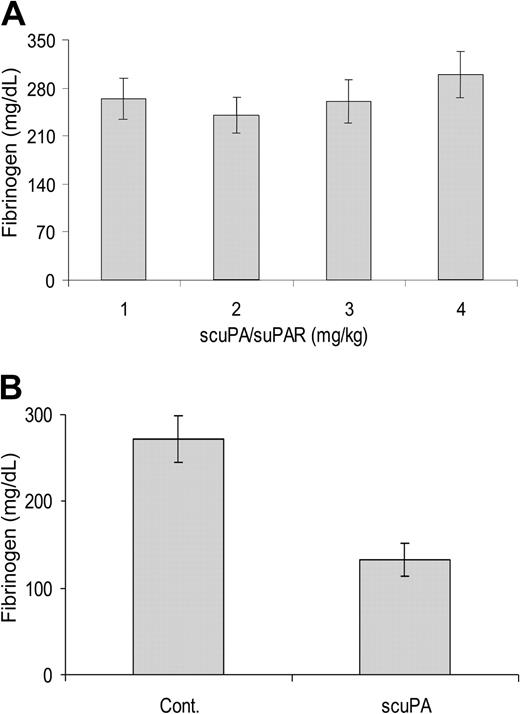
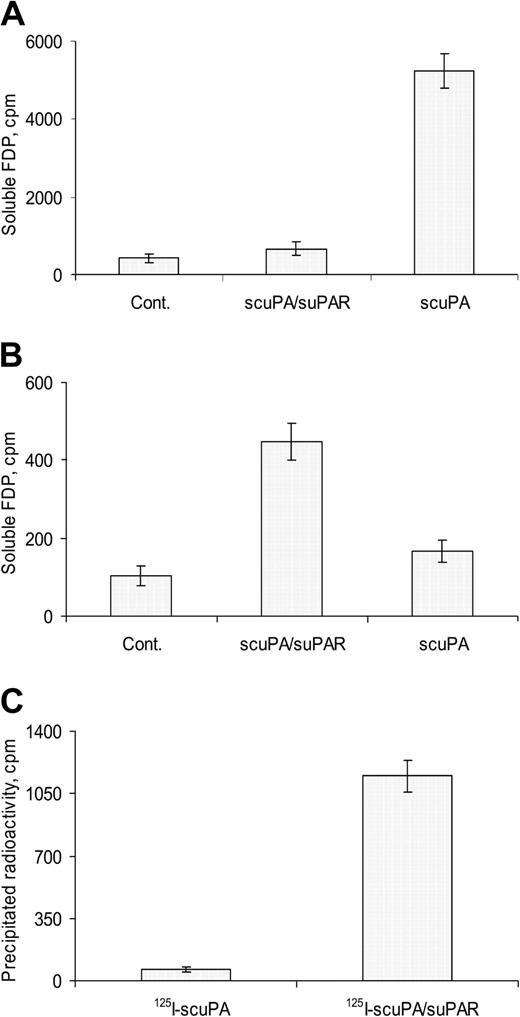
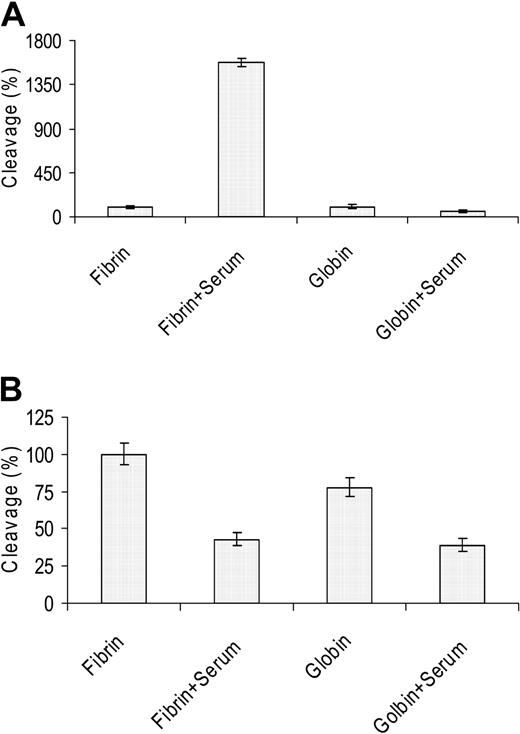

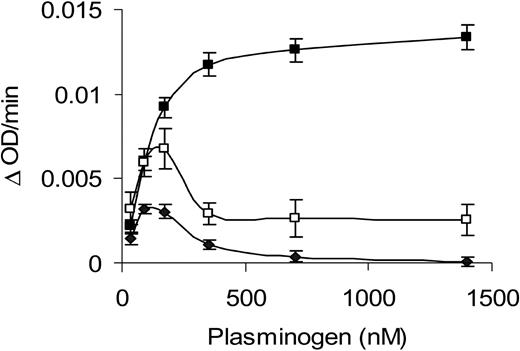

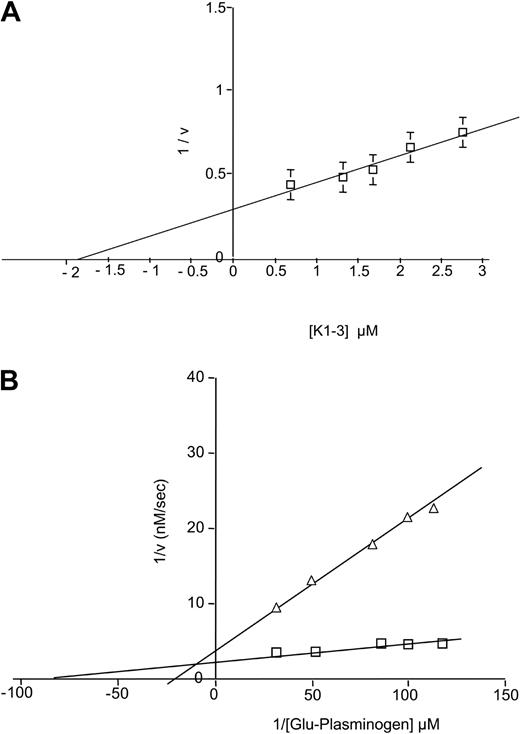
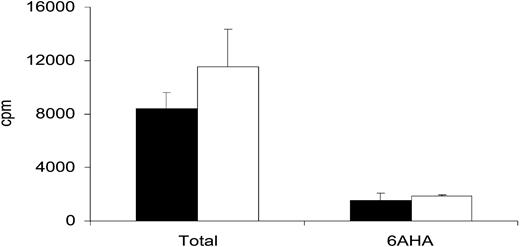

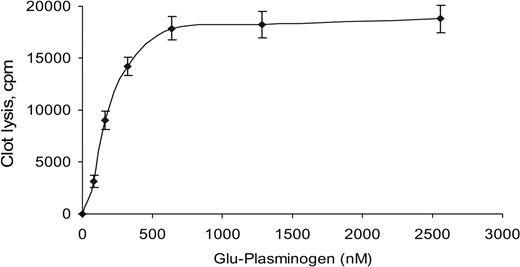

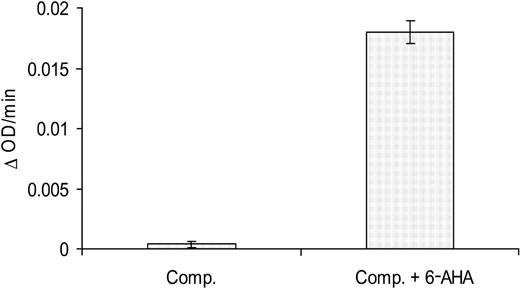
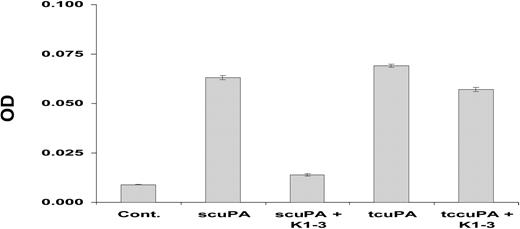
This feature is available to Subscribers Only
Sign In or Create an Account Close Modal